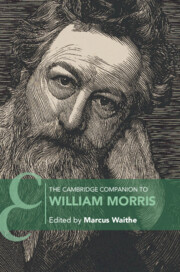Book contents
- The Cambridge Companion to William Morris
- The Cambridge Companion to William Morris
- Copyright page
- Dedication
- Contents
- Figures
- Notes on Contributors
- Acknowledgements
- Note on The Collected Works
- Chronology
- Abbreviations
- Introduction
- Part I Senses of Place
- Part II Authorship
- Chapter 5 Experimental Medievalism
- Chapter 6 Troubling the Heroic Ideal
- Chapter 7 Skaldic Morris
- Chapter 8 ‘The Whole Man’
- Chapter 9 Northern Epic
- Chapter 10 Utopian Fiction
- Chapter 11 Morris’s Prose Romances and the Origins of Fantasy
- Part III The Practical Arts
- Part IV Movements and Causes
- Part V Influences and Legacies
- Guide to Further Reading
- Index
- Cambridge Companions To …
Chapter 9 - Northern Epic
Sigurd the Volsung (1876)
from Part II - Authorship
Published online by Cambridge University Press: 03 May 2024
- The Cambridge Companion to William Morris
- The Cambridge Companion to William Morris
- Copyright page
- Dedication
- Contents
- Figures
- Notes on Contributors
- Acknowledgements
- Note on The Collected Works
- Chronology
- Abbreviations
- Introduction
- Part I Senses of Place
- Part II Authorship
- Chapter 5 Experimental Medievalism
- Chapter 6 Troubling the Heroic Ideal
- Chapter 7 Skaldic Morris
- Chapter 8 ‘The Whole Man’
- Chapter 9 Northern Epic
- Chapter 10 Utopian Fiction
- Chapter 11 Morris’s Prose Romances and the Origins of Fantasy
- Part III The Practical Arts
- Part IV Movements and Causes
- Part V Influences and Legacies
- Guide to Further Reading
- Index
- Cambridge Companions To …
Summary
With striking consistency Morris’s 1877 epic Sigurd meets the principal criteria of its genre. The poem makes its story the vehicle for conveying culturally definitive lore and values, and imbues its heroic actors with the aim of earning a place in that story. The first paginal opening of the 1898 Kelmscott edition embodies this consistency, in imagery and typography that constitute a bibliographical and prosodic rite of passage inducting the reader into a balance of fullness with order that typifies the whole. This aesthetic-ethical balance is then repeatedly thematized along the poem’s synchronic and diachronic axes: e.g., on one hand panoramic vistas, on the other hand sweeping narrative renditions of cosmology and prophecy; or the pivotal “house” figure, which doubles as doomed architectural structure and as tragically concatenated lineage. Morris’s epic moreover incorporates, among other constituent modes like pastoral and romance, the newly ascendant Victorian genre of domestic fiction, which, after dominating the story with the novel-like marital intrigue and foregrounded subjectivity of book 3, yields across the final book to the epic obsequies of Sigurd and Brynhild and the final conflagration of the royal palace at Gudrun’s implacably vindictive hand.
- Type
- Chapter
- Information
- The Cambridge Companion to William Morris , pp. 122 - 134Publisher: Cambridge University PressPrint publication year: 2024

